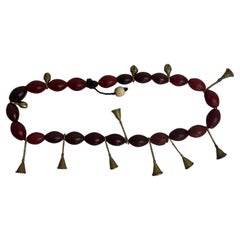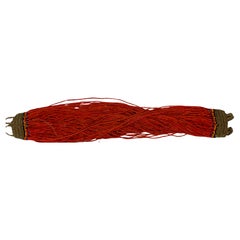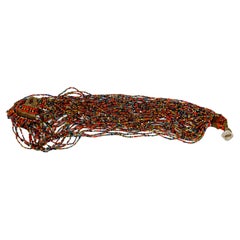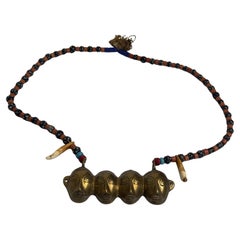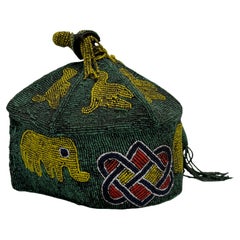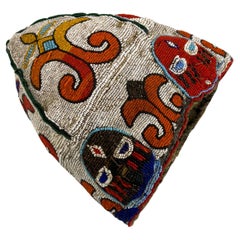Zebregs&Röell Furniture
to
4
271
267
4
5
1
1
1
1
122
78
67
4
52
4
1
1
1
114
93
38
30
30
175
67
59
54
48
271
271
271
2
2
1
1
1
A Naga necklace made of red glass paste beads and bronze trumpets
Located in Amsterdam, NL
Ao tribe, Nagaland, Eastern India, Early 20th century
Made from red glass paste beads and bronze trumpets and bells.
The Ao tribe primarily inhabits the Mokokchung district of Naga...
Category
Early 20th Century Indian Tribal Art
Materials
Bronze
A beautiful beaded from the Bonda people of Orissa
Located in Amsterdam, NL
Bonda people, Orissa, early 20th century
The Bonda people are an indigenous tribal group predominantly found in the hilly areas of Malkangiri district in Odisha (Orissa), India. Recognized as one of the oldest and most traditional tribes in the country, they are often regarded as part of the "Adivasi," or the original inhabitants of the region.
Bonda women are renowned for their distinctive traditional attire and adornments. They wear a minimal garment called nala around their waist and embellish themselves with heavy jewelry crafted from beads, metal, and coins. Their hair is typically styled into a bun and covered with a beaded headpiece...
Category
Early 20th Century Indian Tribal Art
Materials
Metal
A very colourful beaded necklace
Located in Amsterdam, NL
Bonda people, Orissa, early 20th century
The Bonda people are an indigenous tribal group predominantly found in the hilly areas of Malkangiri district in Odisha (Orissa), India. Recognized as one of the oldest and most traditional tribes in the country, they are often regarded as part of the "Adivasi," or the original inhabitants of the region.
Bonda women are renowned for their distinctive traditional attire and adornments. They wear a minimal garment called nala around their waist and embellish themselves with heavy jewelry crafted from beads, metal, and coins. Their hair is typically styled into a bun and covered with a beaded headpiece...
Category
Early 20th Century Indian Tribal Art
Materials
Metal
A beaded Naga 'Headhunter' trophy necklace
Located in Amsterdam, NL
Nagaland, North-east India, early 20th century
A necklace comprised of glass beads, two dog tooth and a brass face pendant. The four headed pendant symbolises decapitated head-troph...
Category
Antique 19th Century Indian Tribal Art
Materials
Brass
A colourful Yoruba beaded crown
Located in Amsterdam, NL
Yoruba People, Nigeria, 20th century
Provenance:
- Collection Rinck Hollnberger, Munich (purchased in the 1980s or 1990s)
Category
20th Century Nigerian Tribal Art
Materials
Beads
A colourful beaded Yoruba 'crown'
Located in Amsterdam, NL
Yoruba People, Nigeria, 20th century
Provenance:
- Collection Rinck Hollnberger, Munich (purchased in the 1980s or 1990s)
Category
20th Century Nigerian Tribal Art
Materials
Beads
A bridal headdress from Papua called 'ambusap'
Located in Amsterdam, NL
Iatmul, Papua New Guinea, 20th century
This ceremonial headdress is traditionally worn by a young bride as she enters her new husband’s home for the first time. Adorned with shells—...
Category
Antique 19th Century Papua New Guinean Tribal Art
Materials
Shell, Natural Fiber
Naga Konyak double fish tail trophy necklace
Located in Amsterdam, NL
Nagaland, North-east India, early 20th century
Made of old glass beads with a bronze adornment in the shape of a double fish tail.
Provenance:
- Collection Rinck Hollnberger, Munic...
Category
Antique 19th Century Indian Tribal Art
Materials
Bronze
A collection of four Ifugao warrior bracelets
Located in Amsterdam, NL
Bontoc or Ifugao people, Northern Luzon, Phillipines, 19th century
The Bontoc and Ifugao peoples of northern Luzon crafted armbands like this one, made from two pairs of wild boar o...
Category
Antique 19th Century Philippine Tribal Art
Materials
Rattan, Wood
An Achuar feather headring
Located in Amsterdam, NL
Achuar people, Perú, Amazon region, early 20th century
Category
Early 20th Century Peruvian Tribal Art
Materials
Natural Fiber, Feathers
A male ceremonial armband made with bat-teeth
Located in Amsterdam, NL
Papua New Guinea, late 19th/early 20th century
Male ceremonial 'armband' made of bat teeth drilled and tied in a double row to a woven band of palm fibre.
Category
Antique Late 19th Century Papua New Guinean Tribal Art
Materials
Natural Fiber, Beads, Teeth
A monkeytooth bracelet from the Philippines
Located in Amsterdam, NL
Philippines, late 19th/early 20th century
Provenance:
Sammlung Rinck-Hollnberger, Munich (purchased the 1980s-1990s)
Category
Antique Late 19th Century Philippine Tribal Art
Materials
Natural Fiber, Teeth
A Baimaru Kundu drum from the Schulze Westrum collection
Located in Amsterdam, NL
New Guinea, Papua Gulf, probably Baimaru people, late 19th–early 20th century
H. 81.5 x Diam. 15 cm.
Provenance:
- Collected by German biologist and cinematographer Thomas Schulze-...
Category
Early 20th Century Papua New Guinean Tribal Art
Materials
Animal Skin, Wood
An Illongot headdress
Located in Amsterdam, NL
Ifugao, Northern Philippines, 19th century
Decorated with different kinds of beadwork and the bill of a Kalaw bird (hornbill).
Historically, only those who had proven themselves th...
Category
Antique 19th Century Philippine Tribal Art
Materials
Shell, Natural Fiber, Wood, Beads
An Asmat ceremonial trophy necklace
Located in Amsterdam, NL
Asmat People, South Papua, Indonesia, probably late 19th century
The Asmat people of Papua are known for creating "trophy necklaces," intricate pieces often made from human bones an...
Category
Antique Late 19th Century Indonesian Tribal Art
Materials
Bone, Natural Fiber
Two Naga hunting trophy chains
Located in Amsterdam, NL
Nagaland, North-east India, early 20th century
Probably made from dogteeth.
Category
Early 20th Century Indian Tribal Art
Materials
Shell, Beads, Teeth
An elaborate collection of stone tools used by the Mapuche culture
Located in Amsterdam, NL
Mapuche Culture, Southern Chile, Pre-Columbian
A collection of eleven stone tools all varying in sizes.
Category
Antique 15th Century and Earlier Chilean Tribal Art
Materials
Stone
An exquisite collection of thirteen Indian arrows
Located in Amsterdam, NL
India, early 19th century
Category
Antique Early 19th Century Indian Arms, Armor and Weapons
Materials
Metal
An exquisite warrior's headdress or 'Kaibauk'
Located in Amsterdam, NL
Amarasi district, Kupang regency, West Timor island, early 20th century
Category
Early 20th Century Timorese Tribal Art
Materials
Metal
Very rare Melanesian armbands made of woven palm fibers and tiny shells
Located in Amsterdam, NL
Melanesia, Southwestern Pacific Ocean, 19th century
Some very rare Melanesian armbands made of woven palm fibers and tiny shells, dating from the 19th century (at least).
This typ...
Category
Antique 19th Century Solomon Islands Tribal Art
Materials
Shell, Natural Fiber
Two spearheads used as currency by the Bangala people of the Congo
Located in Amsterdam, NL
Democratic Republic of Congo, late 19th century
These spearheads looked like weapons, yet they were hardly ever used in battle. Rather, they functioned as a kind of money that was u...
Category
Antique Late 19th Century Congolese Tribal Art
Materials
Iron
A delicate tortoiseshell 'armband' from the Lower Sepik River Province
Located in Amsterdam, NL
Sepik River Province, Papua New Guinea, probably late 19th century
Tortoiseshell bracelets are frequently more than just ornaments in Sepik River civilizations; they are representat...
Category
Antique Late 19th Century Papua New Guinean Tribal Art
Materials
Tortoise Shell
A Polynesian war-club or 'Gata waka'
Located in Amsterdam, NL
Fiji, probably early 20th century
Polynesian culture is traditionally a culture of power and prestige, and there was a fine line between battle and ceremony. Warrior people par exce...
Category
Early 20th Century Fijian Tribal Art
Materials
Hardwood
A Maasai throwing club or 'rungu'
Located in Amsterdam, NL
Maasai, African Great Lakes Region, Probably early 20th century
The 'rungu' is a traditional weapon and emblem of authority among the Maasai people of East Africa, especially in Ken...
Category
Early 20th Century Kenyan Tribal Art
Materials
Hardwood
A beautifully decorated Burmese bronze elephant bell
Located in Amsterdam, NL
Myanmar, 19th century
The bells were commonly crafted from bronze using the lost-wax casting technique, which enabled artisans to create intricate designs. Many showcase detailed mo...
Category
Antique 19th Century Burmese Sculptures and Carvings
Materials
Bronze
Beautiful agate African trade beads
Located in Amsterdam, NL
Probably Togo, Africa, probably early 20th century
Trade or slave beads formed an essential element in trade networks between Europe, Africa, Asia, the Pacific and America, from the...
Category
Early 20th Century Togolese Collectible Jewelry
Materials
Agate
An Anthropomorphic Celt Axe God Pendant
Located in Amsterdam, NL
Central-America, Costa-Rica, Pre-Columbian
Jadeite and other greenstones were utilized in a diverse array of items that served as symbols of social and political power. Among the mo...
Category
Antique 15th Century and Earlier Costa Rican Tribal Art
Materials
Stone
An engraved Sepik cassowary bone dagger
Located in Amsterdam, NL
Papua New Guinea, Sepik Region, Abelam people, early 20th century
Bone daggers in the Sepik region are traditionally crafted from the thigh bone of the ca...
Category
Antique Late 19th Century Papua New Guinean Tribal Art
Materials
Bone
Konyak naga-necklace with brown beads
Located in Amsterdam, NL
Naga Konyak, North-India, early 20th century
The Konyaks, the largest of the Naga ethnic groups, reside primarily in the districts of Tirap, Longding, and Changlang in Arunachal Pra...
Category
Early 20th Century Indian Tribal Art
Materials
Beads
A Solomon Islands red feather money coil or 'Tevau'
Located in Amsterdam, NL
Santa Cruz, Nendö, late 19th/early 20th century
Retaining an original leaf in which these coils were wrapped.
L. 72 cm (stretched out)
Diam. 34 cm (roll)
One of the most remarkabl...
Category
Antique Late 19th Century Solomon Islands Tribal Art
Materials
Feathers
An ancient Papua wooden substitute headhunters's head
Located in Amsterdam, NL
Papua New Guinea, 18th-19th century
L. 22.5 x W. 18 cm (approx.)
Provenance:
Collected by Schulze-Westrum
Collection Rinck Hollnberger, Munich (purchased in the 1980s or 1990s)
For a comparable skull see the collection of the Metropolitan Museum of Art in New York.
The heads of humans and of animals such as crocodiles and pigs formerly played integral roles in the ceremonial life of Papuan Gulf peoples, who considered the heads to be vessels of life-giving supernatural power. Within men’s ceremonial houses, human skulls were displayed, together with sacred images such as spirit boards or gope, by the members of each clan in a specially constructed clan shrine. However, not all heads required the death of an enemy. In some areas, heads made from wood or other materials appear to have had powers equal to actual ones. In contrast to skulls, the facial features of wood heads were sometimes depicted as they appeared in life.
This example comes from the Wapo Creek area, where wood heads appear to have been used interchangeably with actual skulls. When headhunting was abolished by Australian colonial...
Category
Antique 19th Century Papua New Guinean Tribal Art
Materials
Wood
A rare Papua 'Gope' Spirit board from the Schulze Westrum collection
Located in Amsterdam, NL
A rare Papua 'Gope' Spirit board from the Schulze Westrum collection
New Guinea, Papua Gulf, probably Urama people, late 19th–early 20th century
Attached to the back are several 'b...
Category
Antique Late 19th Century Papua New Guinean Tribal Art
Materials
Wood
A rare Papua 'Gope' Spirit board from the Schulze Westrum collection
Located in Amsterdam, NL
A rare Papua 'Gope' Spirit board from the Schulze Westrum collection
New Guinea, Papua Gulf, probably Minagoiravi, Wapo River, late 19th–early 20th century
H. 130 x W. 24.5 cm
Pro...
Category
Antique Late 19th Century Papua New Guinean Tribal Art
Materials
Wood
A rare Papua 'Gope' Spirit board from the Schulze Westrum collection
Located in Amsterdam, NL
A rare Papua 'Gope' Spirit board from the Schulze Westrum collection
New Guinea, Papua Gulf, probably Urama people, late 19th–early 20th century
H. 114 x W. 27 cm
Provenance:
- Co...
Category
Antique Late 19th Century Papua New Guinean Tribal Art
Materials
Wood
A Nias nobleman's gold ‘nifato-fato’ necklace
Located in Amsterdam, NL
Indonesia, North Sumatra, Nias, 19th-20th century
A crescent-shaped gold necklace hammered into folded ridges, the end fastened by interlocking hooks.
Diam. 27 cm
Provenance:
Col...
Category
Antique Late 19th Century Indonesian Collectible Jewelry
Materials
Gold
A late Hellenistic conical marble bowl
Located in Amsterdam, NL
Greek, Eastern Mediterranean, mid 2nd to early 1st century BCE
The bowl with an uneven, rounded rim, and the straight side, tapering diagonally downward.
H. 8.5 x Diam. 15 cm
Pro...
Category
Antique 15th Century and Earlier Greek Decorative Bowls
Materials
Marble
A mirror with the Medici coat-of-arms by Leonardo van der Vinne (act. 1659-1713)
Located in Amsterdam, NL
Florence, late 17th-century
The octagonal mirror decorated with scrolling vines and flowers the top and bottom each decorated with the Medici coat-of-arms in opposite colours, the ...
Category
Antique Late 17th Century Italian Wall Mirrors
Materials
Bone, Mother-of-Pearl, Ebony, Teak
An elaborate Minangkabau gem-set brass floral wedding crown or 'Suntiang'
Located in Amsterdam, NL
An elaborate Minangkabau gem-set brass floral wedding crown or 'Suntiang'
West Sumatra, Minangkabau, probably 1st half 20th century
H. 66.5 cm (incl. stand)
Provenance: Private co...
Category
Mid-20th Century Indonesian Metalwork
Materials
Brass, Enamel
A superb Minangkabau red-enamelled and brass wedding crown or 'Suntiang'
Located in Amsterdam, NL
A Minangkabau red-enamelled and brass wedding crown or 'Suntiang'
A Minangkabau red-enamelled and brass wedding crown or 'Suntiang'West Sumatra, Minangkabau, probably 1st half 20th ...
Category
Mid-20th Century Indonesian Metalwork
Materials
Brass, Enamel
A superb Chinese export famille rose porcelain VOC teapot and pattipan saucer
Located in Amsterdam, NL
China, circa 1730
Porcelain decorated in rose-pink, yellow and soft blue- green enamels, on a shield a lion rampant crowned, holding in his left paw a bunch of seven arrows symbolis...
Category
Antique 1730s Chinese Chinese Export Ceramics
Materials
Enamel
A fine pair of Japanese export lacquer secretaires owned by Sir Stamford Raffles
Located in Amsterdam, NL
'The Stamford Raffles Secretaires.'
A pair of Japanese Kyoto-Nagasaki style export lacquer secretaires by ‘Lakwerker Sasaya’ each with the name ‘Ol...
Category
Antique Early 19th Century Japanese Secretaires
Materials
Gold, Brass
African Chief’s gilt Crown and Sceptre in the form of a Pith helmet and pipe
Located in Amsterdam, NL
A splendid Bouelé Chief’s gilt-wood crown and sceptre in the form of a Pith helmet and pipe
Ivory coast, late 19th/early 20th century
H. 13 x L. 33.5 x D. 26 cm (crown)
L. 14 cm ...
Category
Antique Early 1900s Ivorian Tribal Art
Materials
Giltwood
A superb Dutch-colonial Indonesian silver filigree sirih box
Located in Amsterdam, NL
Probably Sumatra, Padang, 18th century
H. 8.4 x W. 22.5 x D. 15.3 cm
Weight 1700 grams
Due to the form of this box, together with the date, the most likely place of production of t...
Category
Antique 18th Century Indonesian Dutch Colonial Jewelry Boxes
Materials
Silver
An Indo-Portuguese colonial tortoiseshell veneered wooden casket
Located in Amsterdam, NL
India, probably made in Gujarat for Portuguese Goa, late 17th/early 18th century
The tortoiseshell laid over gold foil, and the interior with red lacquer and possibly later added re...
Category
Antique Late 17th Century Indian Jewelry Boxes
Materials
Silver
An Indian part-gilt silver-clad ceremonial sceptre or mace with a tiger’s head
Located in Amsterdam, NL
Northern India or Deccan, late 19th century
L. approx. 82 cm (excl. stand)
Provenance:
Private collection, United Kingdom
This remarkable gilt-silver soonta (ceremonial sceptre) also known as choba (ceremonial mace) with a tiger's head stands out as an unparalleled example. It has a wooden base, clad with thick sheet part-gilt silver and has fine details such as teeth and a curling tongue. Especially with the inlaid glass eyes, in combination with the grand sculptural design, it would have been integral to an Indian maharaja’s attire, known as lawajama in North India and biruthus in South India, as referenced by Jackson & Jaffer. They would symbolise authority, power, and sometimes an attribute of various deities, particularly those associated with strength or combat. For instance, the Hindu god Hanuman, known for his immense strength, is often depicted holding a mace (*chob* or gada in Sanskrit). Similarly, the god Vishnu and his avatar Krishna are also frequently depicted with a mace among their other attributes.
Courtiers would raise these sceptres wrapped in rich brocades, with the head visible, during processions, signalling their association with the monarch. Alongside fly-whisks and standards, they were indispensable in ceremonial parades, underscoring the ruler's prestige. Terlinden notes that a soonta berdar was tasked with carrying the sceptre. These individuals, proficient in courtly manners, played key roles during audiences, from managing entrances to introducing guests. Their esteemed position often earned them generous rewards, including land grants. See for a depiction of sceptres in use the top right of a painting in the collection of the V&A, titled Processional scene with Amar Singh, ruler of Thanjavur (Tanjore), and Sarabhoji, from circa 1797.
For a very comparable piece, but with an elephant’s head, see the collection of the Indian Museum, Kolkata. For other less similar examples, see the V&A Museum London.
Sources:
A. Jackson & A. Jaffer, Maharaja: The Splendour of India’s Royal Courts, London, V&A Publishing, 1999
Christiane Terlinden Serra, Mughal Silver...
Category
Antique Late 19th Century Indian Metalwork
Materials
Silver
A pair of Spanish-colonial Viceregal mother-of-pearl inlaid bureau-cabinets
Located in Amsterdam, NL
Viceroyalty of Peru, Lima, 18th century, circa 1720-1760
Each with a moulded giltwood cornice and on a foliate carved giltwood base, possibly later and English. The cabinets, with s...
Category
Antique 18th Century Peruvian Spanish Colonial Cabinets
Materials
Mother-of-Pearl, Teak
A Dutch colonial ebony box with silver mounts
Located in Amsterdam, NL
Batavia (Jakarta), or Sri Lanka, circa 1680-1720
The document or money box is densely carved with fine scrolling vines and lotus flowers. It has a charming heart- shapes silver lock...
Category
Antique Late 17th Century Indonesian Dutch Colonial Antiquities
Materials
Silver
A small Dutch colonial Indonesian tortoiseshell betel box with gold mounts
Located in Amsterdam, NL
Jakarta (Batavia), 18th century, apparently unmarked
L. 14 x W. 9.5 x H. 4.7 cm
Before settling down to business in the former Dutch East Indies, sirih had to be offered in the mos...
Category
Antique Late 18th Century Indonesian Dutch Colonial Antiquities
Materials
Gold
An extremely rare, possibly unique, Sri Lankan ebony child's armchair
Located in Amsterdam, NL
Probably Sri Lanka, 2nd half 17th century
H. 55 x W. 40.5 x D. 40.5 cm
Seat height 27.5 cm
The chair is overall densely carved with a scrolling flower motif on four connected turne...
Category
Antique Late 17th Century Indonesian Dutch Colonial Furniture
Materials
Ebony
A large Dutch colonial ebony cabinet with brass mounts
Located in Amsterdam, NL
A Dutch colonial ebony cabinet with brass mounts on contemporary black steel frame
Batavia (Jakarta), 2nd half 17th century
The cabinet has two ...
Category
Antique Mid-17th Century Indonesian Dutch Colonial Antiquities
Materials
Brass
A rare Japanese Namban export lacquer coffer with Mon emblems
Located in Amsterdam, NL
Late Momoyama period, late 16th century
The coffer is decorated in black lacquer, urushi, on cedar wood, decorated with gold dust and silver, maki-e, and nashiji, mother-of-pearl, r...
Category
Antique 16th Century Japanese Lacquer
Materials
Silver, Copper
A Chinese export reverse-glass painting after an English print in original frame
Located in Amsterdam, NL
Canton, late 18th century
In original hardwood frame with ruyi-shaped metal mount for suspension.
H. 38.7 x W. 44.3 cm (incl. frame)
H. 31.8 x W. 37.5 cm (image)
Chinese reverse glass paintings for export are known since mid 18th century. By the 1780's the copying of European, mainly English, engravings came into vogue in Chinese paintings on glass...
Category
Antique Late 18th Century Chinese Chinese Export Paintings and Screens
Materials
Glass, Hardwood
A 17th century Dutch-colonial ebony two-door VOC cabinet with silver mounts
Located in Amsterdam, NL
A Dutch-colonial ebony two-door cabinet with silver mounts
Coromandel Coast, probably Masulipatnam, circa 1650-1680, the silver later
H. 64.5 x W. 75 x D. 46 cm
The present cabinet...
Category
Antique 17th Century Indian Dutch Colonial Antiquities
Materials
Silver
A rare Indonesian tortoiseshell sirih casket with gold mounts
Located in Amsterdam, NL
Batavia (Jakarta), 19th century, apparently unmarked
H. 5 x W. 18 x D. 13 cm
Before settling down to business in the former Dutch East Indies, sirih had to be offered in the most e...
Category
Antique 19th Century Indonesian Jewelry Boxes
Materials
Gold
A Nias 'Adu Zatua' wooden ancestor sculpture
Located in Amsterdam, NL
Indonesia, Nias, 19th century
H. 37.5 x W. 10 cm
Sculptures like the one present are not only decorative items but are believed to be vessels that house the spirits of ancestors and are used to communicate with them.
After the death of a person a wooden image or Adu Zatua was made to mediate between the human world and the spiritual realm. These kinds of figures were commissioned by noble Nias families, whereas simple and lesser quality carvings generally were found among lower class families.
In this particularly fine example, the sculptor has paid careful attention to the proportions of the different parts of the body, dividing it into three main sections – the head, the torso, and the legs. The shapes are sometimes flat, round, or have notches, but all are perfectly in balance creating a certain divine tranquillity. This Adua Zatua’s ears are decorated with earrings, and it is wearing a headdress, pointing towards a chiefly provenance.
In 1914 the Dutch gained complete control of the island of Nias and started spreading Protestant Christianity. Many ancestor statues...
Category
Antique 19th Century Indonesian Tribal Art
Materials
Wood
A Japanese Nagasaki-e print depicting the arrival of Dutch ships in Nagasaki
Located in Amsterdam, NL
Published by Bunkindõ han, circa 1801
Colour woodblock print, H. 32.5 x W. 48 cm
Under this view of Nagasaki Bay, the text states that the first Dutch ships arrived in Nagasaki in ...
Category
Antique 18th Century Japanese Prints
Materials
Paper
A Chinese huanghuali, wumu and mother-of-pearl watch holder
Located in Amsterdam, NL
Canton, 2nd half 19th century
H. 22.5 x W. 30 x D. 12.5 cm
The pocket watch, an antique Swiss triple calendar Moon phace pocket watch in gunmetal case, dating from around 1860-1900, is marked Acier Garanti, Oxidage Inalterable, and is numbered. The stand, made of huanghuali (Dalbergia odorifera...
Category
Antique 19th Century Chinese Chinese Export Furniture
Materials
Wood
A Japanese export lacquer box with depiction of the Grand Hotel, Yokohama
Located in Amsterdam, NL
Meiji period, circa 1873-1887
The black lacquered box decorated in maki-e and hiramaki-e gold, with on the lid a European style building complex and several Japanese and European figures walking along a street in the foreground. The sides are finely decorated with several insects and the inside with several compartments and nashiji decoration.
H. 7.4 x W. 29 x D. 25.7 cm
After the Americans forced Japan to open their harbours to the outside world and take part in international treaty and trade around the mid 19th century, the formerly feudal society rapidly changed. Japan was now focussing on an industrial future. One of the major international ports was Yokohama with its foreign embassies and warehouses - which attracted a great number of visitors of all sorts. For the higher society visiting Japan for the first time a new and ‘Western’ hotel had to be realised; hence the construction of The Grand Hotel on Kaigandori.
The hotel was opened on August 16, 1873 (Meiji 6) and was soon considered the height of Western culture and elegance in Japan. The building probably depicted on this box, designed by American architect Richard P. Bridgens (リチャード・ブリジェンス, 1819 -1891), is the original hotel...
Category
Antique 19th Century Japanese Lacquer
Materials
Gold
A fine Dutch 18th-century oak and amboyna bureau cabinet with mirror doors
Located in Amsterdam, NL
The Hague, circa 1760
Oak, veneered with amboyna root, brass fittings with lacquer gilding.
H: 242 cm. , W: 120 cm. , D: 62 cm.
Provenance: Private collection Germany
The bureau cabinet is a piece of furniture that has become very popular in the Netherlands since the early 18th century. This example was made around 1760. The single curved base cabinet...
Category
Antique 18th Century Dutch Baroque Cabinets
Materials
Brass
A Superb Dutch 18th-century Rococo cabinet atributted to Matthijs Franses
Located in Amsterdam, NL
Dutch rococo cabinet atributted to Matthijs Franses, in the style of Abraham Roentgen
The Hague, circa 1765
266 high, 193 wide and 70 cm deep
Oak an...
Category
Antique 18th Century Dutch Rococo Cabinets
Materials
Brass
